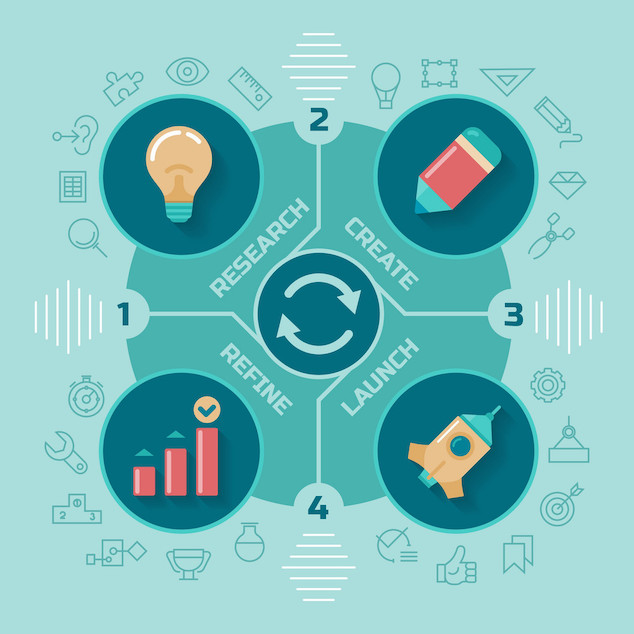
Organizing Your Agency’s Creative Workflows: Streamlining and breaking down your client’s projects to bring creative solutions timelessly.
Creativity can’t be scheduled; the muse may come and leave at her discretion, leaving some creative workers with pending deadlines and with no ideas to implement. But when you’re an owner of a creative agency and have contracts with clients, you can’t afford to wait for your staff’s creative juices to flow. It would be best to organize the team’s work so that it doesn’t undermine their deadlines and helps everyone do their job well and on time. Here is a quick glance at how a skilled manager can organize creative workflows to minimize the risk of project delays and poor-quality work.
#1 Set Creative Workflow Management Objectives and Milestones
A creative project only seems to be a puzzle when you take a bird’s eye view of it. Once you start digging deep into the processes and small tasks requiring completion, you see the structure and can organize things effectively. As Amanda Gomez, a Project Manager at Write My Paper For Me, pointed out, creative flow management is about establishing end goals and drawing as many intermediate points of getting to those goals as you can. Visualizing the process of project completion with small, doable tasks makes the whole project much more manageable.
Thus, before proceeding to project execution, you can set up a well-organized creative workfl
- The target audience of the project
- The client’s key requirements and optional preferences
- The project’s deadline and resources required for its completion
- The project’s key milestones
- The project’s budget
Based on this entry data, you’ll design a manageable plan that the whole team will follow.
#2 Break Down the Creative Workflow Process into Tasks
As we’ve already mentioned, dividing a large project into small, manageable tasks is a great way to move from a vague concept to a set of doable tasks. However, in addition to the list of tasks, you need to establish an effective system of task succession. When numerous workers handle one project, the conflict of roles, the vagueness of responsibilities, and delay on one worker’s part may undermine the entire project’s success.
To avoid any creative workflow process-related complications, you need to take care of the following:
- Assign team members responsible for each stage (you should always have a team lead responsible for all tasks’ coordination, a strategist, a marketing specialist, a designer responsible for the project’s visual components, and a developer handling all technicalities).
- Inform the team about communication methods for informing each other about essential milestone completion and status of tasks.
- Set up an effective file organization system.
- Monitor the team’s productivity consistently.
- Invest time and resources into the teams’ collaboration skills.
- Consider putting in place recruitment for agile teams.
#3 Keep Everyone in the Loop
Communication is key when it comes to working with clients. Customers tend to come to agencies with more work if they see that their interests are respected and regularly informed about the project’s progress. Thus, you need to have an effective communication system and updates for the clients concerned about how their projects progress. To maximize the value of client-agency interactions, you can:
- Give the client access to the creative workflow management spreadsheet to check the status of tasks and see how the project progresses.
- Establish a schedule for communication with clients based on the intermediate results’ display. At those communication sessions, you can ask clients for feedback and double-check whether their expectations are met. In this way, some changes can be introduced at the early stages of project completion.
- Set up the project’s schedule with your client and make sure to meet the established timelines.
- Be realistic in the goal and time estimates to avoid delays and client frustration in the future.
Your team is also a critical element of the project’s completion, so they should also be kept informed about the updates in client-agency communication. Thus, you need to assign a Project Manager coordinating all communication on the project and keeping every involved stakeholder aware of the latest changes and current order progress.
#4 Use Effective Communication Tools
In remote work and COVID-19 isolation conditions, more and more clients assign their creative projects to agencies located far away. Besides, such agencies work with most of their staff on a remote basis. Thus, efficient and timely communication becomes strategically significant in the distributed work environment.

As a party responsible for a creative project’s success, you can maximize the utility of team and client communication with the help of modern communication tools.
- Organize team communication and file sharing. Some popular solutions for this are Slack, Asana, Trello, Wrike, etc. Check each of the popular solutions and choose the one suitable for your goals and project specifics. The core features to focus on are scalability (for instance, you may operate with a team of five right now, but including more staff may cost too high), file sharing and storage capacity, and communication tools.
- Choose conferencing tools. Zoom is a trendy tool for video conferencing today, but you can try other tools as well, including Skype, WhatsApp, or WeChat. Google also offers some handy tools for instant communication and group chats.
- Consider some progress tracking software. If your project is too complex and involves many people and many tasks, using some progress tracking app may make sense. Each team member will enter their progress results there, showing all other team members on which stage of task completion they are. It gives enhanced progress transparency to the entire team, the manager, and the client.
#5 Track Intermediate Progress
It is vital to check the intermediate results against the initially set objectives and discuss them with the client. Such tracking will ensure that you avoid costly mistakes and don’t need to redo half of the project once it’s already finished. Keep in mind that some errors or deviations from the project’s specifications can be quickly corrected within 1-2 hours or days if noticed on time. If you continue working, mounting some new errors on that initial mistake, you risk wasting time and resources on costly revisions upon the entire task’s completion.
An effective system of progress tracking is the Agile or SCRUM methodology. It is mainly applied for IT projects, but you can also adjust it to other spheres to ensure that you end up with a viable end result every check period.
Creativity Can Be Tamed
Now that you’re equipped with the essentials of creative workflow management, you will surely organize processes better, no matter how much creativity they require. Good luck! With each team member understanding their tasks and deadlines, the project gets much more manageable.






